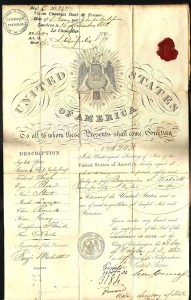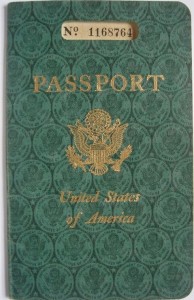The History of the US Passport – The Most Coveted Travel Document in the World

Used from 1789 to the 1900s
The very first American passports were issued during the American Revolution to a small number of citizens who were part of Benjamin Franklin’s mission to France. These first passports were modeled after those issued by the French Government and were no more than a small sheet of paper that had a printed description of the bearer on one side. These had to be renewed at least once every six months. As the nation became better organized, the Foreign Affairs Department was put in charge of issuing passports to all American citizens going abroad.In 1789, the department of Foreign Affairs became the State Department that we know today under the new constitution. They started issuing passports, and many other authorities across the country such as states and cities did so as well until Congress halted the practice in 1856, but these passports were not usually recognized by European nations.
For most of the period between 1789 and World War I, an American passport looked like a high school diploma but slightly larger at 11 X 17 inches in size. The State Department’s seal could be found engraved on the top and set in red wax on the bottom while the bearer’s description and signature were on the left side. On the right side, the bearer’s name and an empty space for additional information such as inoculations, family members or servants who might be traveling with the bearer, and other valuable information that could be filled in.
Oddly enough, another constant through most of this period was, while most European nations required American citizens to have a passport to get in, the United States itself never required people to have one to get in or out. The only exceptions to this period were during the Civil War and during World War I. In May of 1918, Congress passed the Travel Control Act, which allowed the President to require passports during war time. In fact, the passport requirement remained intact until March of 1921, when President Woodrow Wilson’s tenure ended. By this time, passports could last for as long as two years.
Between 1810-1910, over 500,000 passports were issued by the US government, many of which were group or family passports. All of them were issued to men unless the party involved was a child and his or her mother. In that case, the mother received the passport. Women were allowed to carry their own passports by 1920.
In that same year, the League of Nations held a conference on standardizing passports throughout all member countries to simplify traveling by train. This first conference mostly discussed standardizing their appearance, but other rules
were enforced in the mid-1920s. Although the US wasn’t a member of the league, it did adhere to many of the regulations that are still in force today with the passage of the Passport Act and the appearance of the type III passport, both of which took place in 1926.
Passport Books Make Their First Appearance

The new passports issued were the first to resemble those we know today. They had a stiff red cover with a small slot that showed the holder’s passport number. Inside was the description of the holder, and for the first time, the bearer’s picture was also included. It contained 28 empty pages for customs officials to stamp a seal as the holder entered another country. Another innovation that the league created was the requirement of two languages on a passport message. In the case of the United States, the languages used were English and French, which were respectively the national language and the international language of diplomacy. In the late 1990s, a Spanish-language passport message was also added in recognition of Puerto Rico’s status.Even with these innovations, passports weren’t always required to enter the country, between the years of 1921-1941 one could entry the United States without a passport. It wasn’t until the start of World War II when the United States re-invoked the Travel Control Act of 1918, thus requiring them again upon entry. With the advent of the Cold War, laws were finally enacted that made it illegal to enter the United States at any time without a passport. In 1980, the United Nations finally standardized passports around the world under International Civil Aviation Organization guidelines.
By now, the passport had changed colors twice. First, they were green and changed to blue in the 1970s. In 1993, they went to green again for a year and finally reverted to the blue that’s used today. By that year, passport length had been extended to ten years, which is the standard today.
Modern Technology and The US Passport
A major change occurred in 1981 when the US issued machine-readable passports. In 2000, all photos were digitized, and by 2007, new bio-metric passports became the standard with RFID chips installed.
Today’s passport contains the bearer’s digital photo on the left, information such as name, gender, birth date and place, passport number, and the dates of issuance and expiration. They also hold a digital section at the bottom of the ID page that contains a passport chip, which is read by special machines. They still hold 28 pages for stamps, but people can now request a 52-page passport if they travel frequently.

When will the next generation u s passports be available?
Many Basques came to the USA in the early 1900’s. Did they need a passport and was their stay limited to a time period.
That’s a great question and I’m not familiar with 1900’s immigration to the US and the requirements – my own family immigrated around the turn of the century and I never inquired… I’ll queue up the idea for a future post.
There are only 28 and 52 page passports. No 32 page ones.
Did the us passport ever list the person’s religion in it?
Was. Religion ever recorded on a person’s passport?
was there ever a passport issued by the secretary of any one of the united States? and if so what wording did it include??
When did the Department of State create its online passport application system?
My memory of the green passports is that they were about 25% larger, is that true? Also, is the new passport the same size as those of today?
When did the government begin charging? I am planning to renew mine, and am flabbergasted by the cost and complexity involved!